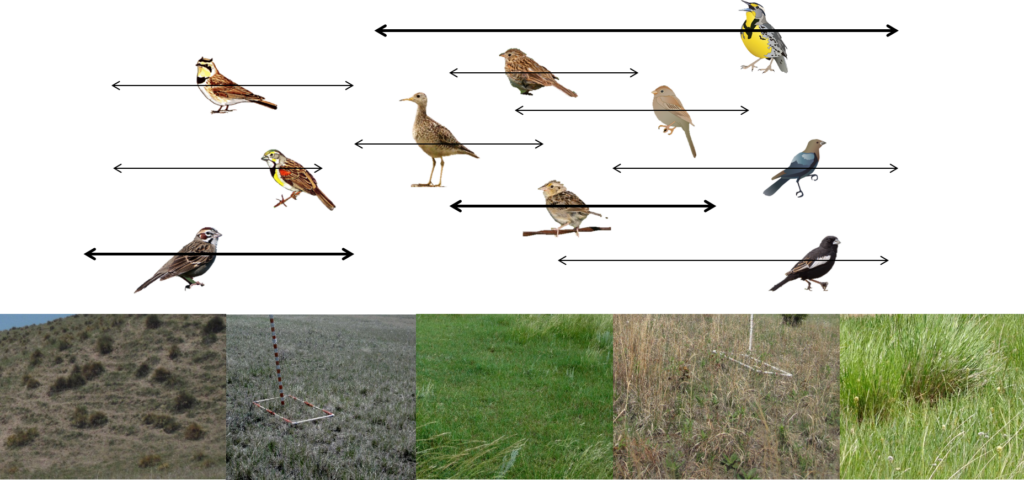Project Overview
Annual Reports
Information Products
Commodities
- Animals: bovine
Practices
- Animal Production: grazing - continuous, grazing management, range improvement, grazing - rotational
- Education and Training: farmer to farmer, networking, participatory research
- Farm Business Management: whole farm planning, new enterprise development, cooperatives, agritourism
- Natural Resources/Environment: biodiversity, habitat enhancement, wildlife
- Production Systems: agroecosystems, holistic management
- Sustainable Communities: community planning, new business opportunities, sustainability measures
Abstract:
Improved livestock distribution and grazing efficiency across the Northern Great Plains has led to structurally homogenous rangelands that greatly limit rangeland plant and animal biodiversity (Toombs et al. 2010, Becerra et al. 2013). Some range scientists have called for a shift to managing rangeland ecosystems for structural heterogeneity and biodiversity at larger scales, rather than managing for even grazing distribution (Fuhlendorf et al. 2012, Freese et al. 2014). However, typical management focuses on optimizing beef production (Ortega-S. et al. 2013, Sliwinski 2017), by promoting preferred forage species and increasing the efficiency of the grazing process (Vallentine 2001). Additionally, fire and burrowing mammals, such as prairie dogs, have been eliminated in an effort to maximize rangeland beef production (Freese et al. 2010, Augustine and Derner 2012, Fuhlendorf et al. 2012). These management decisions homogenize the landscape, thus decreasing habitat available to different wildlife species (Fuhlendorf and Engle 2001).
Because management decisions concerning rangelands are primarily made by private landowners, it is important to understand the attitudes that landowners, primarily ranchers, have about the processes that increase heterogeneity and about cross-boundary management to achieve conservation at larger scales. Thus, the first objective of this research was to examine ranchers’ attitudes about management across boundaries and strategies to create vegetation heterogeneity, and to determine the factors that influenced these attitudes. A second objective of this research was to determine what factors predicted behavioral intentions related to vegetation heterogeneity and cross-boundary management. We used qualitative and quantitative data to understand ranchers' attitudes about habitat heterogeneity and wildlife conservation.
In 2016 we completed the qualitative data analysis with data collected from 11 interviews, which resulted in seven themes: maintain control by reducing risk, wildlife are not our focus, the miracle of animal impact, managing to the middle, perceptions of the good rancher, trust insider, mistrust outsiders, and love of grasslands. We then developed a survey to collected quantitative data from landowners in Nebraska, South Dakota, and North Dakota. We received 595 usable surveys after distributing the survey to 2873 landowners. The analysis of these data indicated that attitudes about fire and prairie dogs were important predictors of a producer’s intent to use management that promotes vegetation heterogeneity or crosses property boundaries.
With the information gained from the interviews and survey, we developed an outreach publication that was mailed to the individuals who completed the mail survey. The publication included general results from the survey related to the topics that were most important to creating heterogeneity, including fire, prairie dogs, and threatened and endangered species.
Project objectives:
The first objective of this study was to explore ranchers' perceptions of habitat heterogeneity and the processes that can create habitat heterogeneity in the Northern Great Plains. This objective was met through a qualitative interview process, to understand ranchers’ opinions of habitat heterogeneity across landscapes. We completed 11 interviews in Nebraska, South Dakota, and North Dakota.
The second objective was to examine ranchers’ attitudes about vegetation heterogeneity, which is crucial for biodiversity in the Great Plains because different wildlife species require different types of habitat. For example, common nighthawks (Chordeiles minor) and mountain plovers (Charadrius montanus) nest on bare ground, whereas field sparrows (Spizella pusilla) and loggerhead shrikes (Lanius ludovicianus) require shrubby habitat (Figure 1). Additionally, we were interested in understanding ranchers’ attitudes about management across property boundaries, because ecosystem processes in the Great Plains, like fire, occur over large landscapes.

Figure 1. Birds in the Northern Great Plains require a variety of habitats, from bare ground to denser grass to shrubby. All of these habitats are required to ensure grassland biodiversity is achieved. (Photographs by M. Sliwinski)
The survey was mailed to ranchers in February 2016 after completing scale development and pilot testing. The variables that were assessed in the survey included attitudes about vegetation heterogeneity, landscape management, agreement with social norms, perceived control over ranch management, land use values, innovativeness, risk aversion, individualism, collectivism, and the intent to engage in behaviors that promote vegetation heterogeneity and landscape management. We also requested demographic information such as age, education, and amount of rangeland managed.